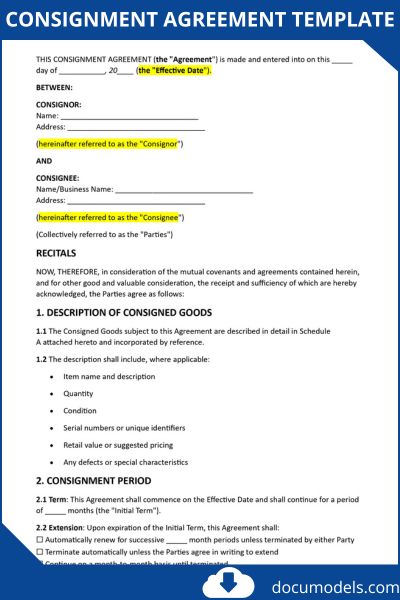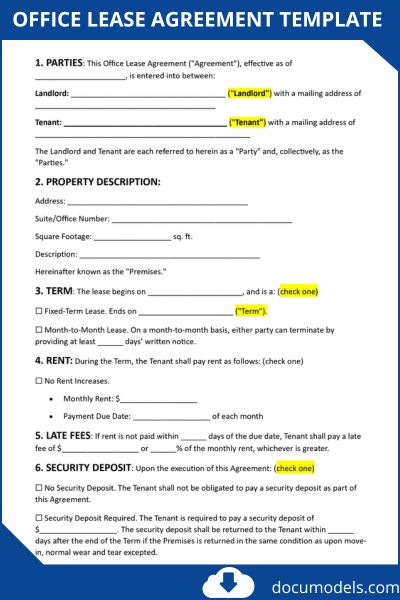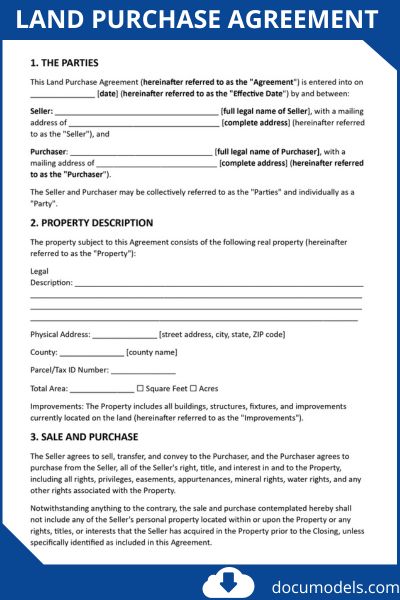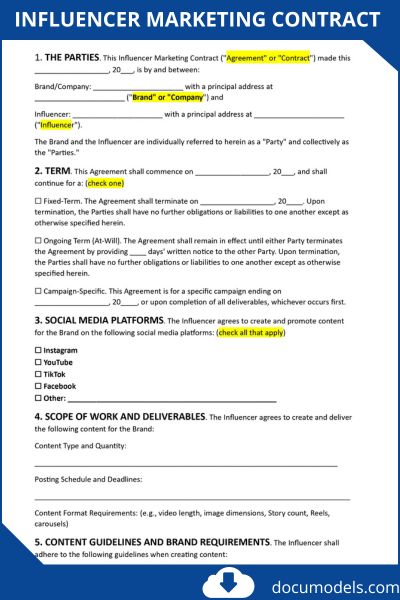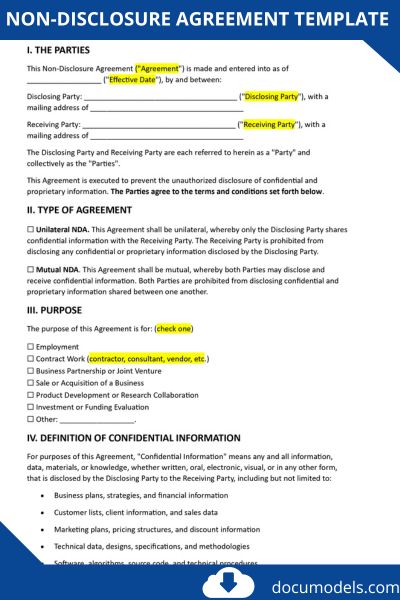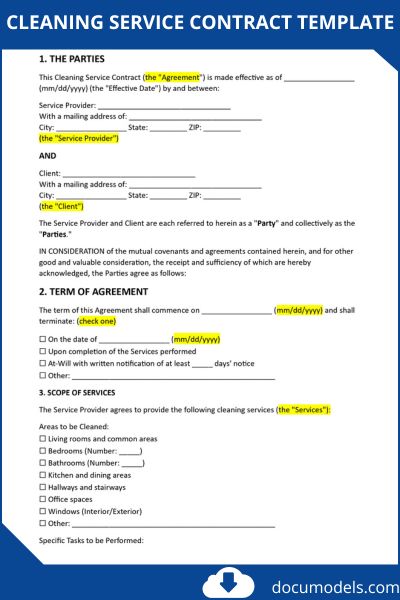When business relationships evolve, contracts often need to evolve with them. Instead of rewriting an entire agreement from scratch, a contract addendum allows you to make clear, legally binding changes while preserving the original document.
Whether you need to adjust payment terms, extend deadlines, add new responsibilities, or clarify existing clauses, an addendum provides a straightforward and professional way to ensure both parties remain aligned.
Understanding how to draft a contract addendum is essential for entrepreneurs, freelancers, business owners, and legal professionals alike. A well‑written addendum not only prevents misunderstandings but also strengthens trust by keeping all agreements transparent and up to date. Without one, even small changes could lead to confusion or disputes down the road.
In this post, we’ll break down what a contract addendum is, why it matters, and the key elements that make it valid and enforceable. To make things even easier, we’ll also share practical examples and ready‑to‑use contract addendum templates you can adapt to your own needs.
Table of Contents
Professional Contract Amendment Templates & Samples
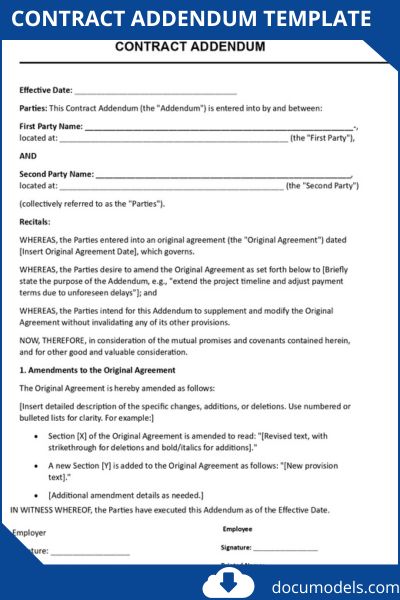
A contract addendum serves as a vital tool for modifying existing contracts without the need for a complete rewrite.
Contract Addendum (Word)Contract Amendment Template
Contract-addendum-templateEmployment Contract Addendum Template
Vendor Contract Addendum Template
What Is a Contract Addendum?
A contract addendum is a separate document that is attached to an original contract to add new terms or information. Think of it as a “P.S.” for your legal agreement. It allows the parties involved to include additional clauses, conditions, or details that were not part of the initial document. Once signed by all parties, the addendum becomes a legally binding part of the original contract.
The key purpose of an addendum is to supplement, not change, the original agreement. It leaves the initial terms intact while introducing new elements. This is useful when circumstances evolve, or when specific details are finalized after the main contract is signed.
Key Characteristics of an Addendum
Not every addition to a contract qualifies as an addendum. To be valid and effective, an addendum should have these key characteristics:
- It’s a Separate Document: An addendum is created as a new document, not as scribbled notes in the margin of the original contract.
- References the Original Contract: The addendum must clearly state the title and date of the original contract it is modifying. This creates a clear link between the two documents.
- It Is Created After the Original Contract: An addendum is used to add terms after the initial agreement has been signed.
- Signed by All Parties: Just like the original contract, an addendum must be signed by all parties involved to be legally enforceable. This signifies their agreement to the new terms.
- It Becomes Part of the Original Contract: Once executed, the addendum is legally incorporated into the original contract as if it had been there from the beginning.
Common Scenarios for Use
Addendums shine in situations where life (or business) throws curveballs after a contract is inked.
Here are some everyday examples:
- Real Estate Transactions: Adding contingencies for home inspections, financing approvals, or repairs after an offer is accepted.
- Lease Agreements: Incorporating pet policies, parking assignments, or maintenance schedules for renters.
- Employment Contracts: Outlining new benefits, remote work terms, or non-compete extensions during onboarding or promotions.
- Sales or Vendor Deals: Updating delivery timelines, payment terms, or product specifications due to supply chain issues.
- Service Agreements: Adding scope for extra work, like expanding a marketing campaign mid-project.
Contract Addendum vs. Contract Amendment
One of the most common mix-ups? Confusing addendums with amendments. Both modify contracts, but they do so differently. An addendum adds new elements, while an amendment changes existing ones.
Here’s a side-by-side comparison:
| Feature | Contract Addendum | Contract Amendment |
| Purpose | Adds new information or terms to a contract. | Changes or modifies existing terms in a contract. |
| Timing | Created after the original contract is signed. | Can be created at any time after the original contract is signed. |
| Function | Supplements the original contract. | Alters the original contract. |
| Example | Adding an exhibit that lists specific equipment to be leased. | Changing the monthly rental price in a lease agreement. |
Legal Enforceability of Addendums
For a contract addendum to be legally binding, it must meet several conditions. If these are not met, a court could rule that the addendum is invalid, leaving you with only the terms of the original contract.
To ensure enforceability:
- Reference the Original Contract: The addendum must explicitly state the original contract’s title, date, and the parties involved. A common phrase is, “This addendum is made to the agreement titled ‘[Contract Name]’ dated [Date].”
- Use Clear and Unambiguous Language: The new terms should be written clearly to avoid any confusion or misinterpretation.
- Obtain Signatures from All Parties: Every party who signed the original contract must also sign the addendum. This confirms their mutual consent to the new terms.
- Follow Original Contract Formalities: If the original contract required signatures to be witnessed or notarized, the addendum should follow the same procedure.
- Attach It: Keep a physical or digital copy of the signed addendum attached to the original contract.
How to Write a Contract Addendum
Writing an addendum doesn’t have to be complicated. Following a standard format ensures clarity and legal validity.
Step-by-Step Guide
1. Create a New Document: Start with a blank page. Title it clearly, for example, “Addendum to Employment Agreement.”
2. Identify the Original Contract: Begin with a clear statement that links the addendum to the original agreement.
Example: “This Addendum (the ‘Addendum’) is made effective as of [Date], and is incorporated into the [Name of Original Contract], dated [Date of Original Contract] (the ‘Agreement’), by and between [Party A Name] and [Party B Name].”
3. List the New Additions: Clearly state the new terms you are adding. Use numbered or lettered paragraphs for readability.
Example: “The Agreement is hereby supplemented by adding the following clause as Section 12:”
“[Insert the full text of the new clause here].”
4. State that Original Terms Remain in Effect: Include a clause confirming that all other terms of the original contract are unchanged and still valid.
Example: “Except as specifically supplemented by this Addendum, all other terms and conditions of the Agreement shall remain in full force and effect.”
5. Add a Signature Block: Create signature lines for all parties, including their printed names, titles, and the date. This should mirror the signature block of the original contract.
Best Practices for Using Addendums
To avoid pitfalls and maximize value, adopt these habits:
- Get Buy-In Early: Discuss changes verbally before drafting to build consensus.
- Use Clear Language: Avoid jargon—aim for readability to prevent disputes.
- Document Everything: Attach copies to all parties and store digitally for easy access.
- Limit Frequency: Too many addendums can clutter; consider a full amendment if changes pile up.
- Seek Legal Review: Especially for high-stakes deals, have a pro check for enforceability.
- Track Versions: Number addendums (e.g., Addendum No. 1) to maintain order.
Related Articles:



